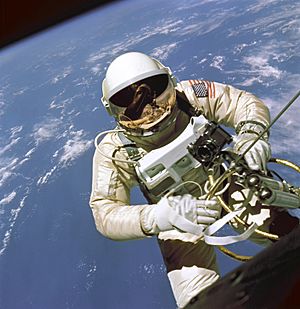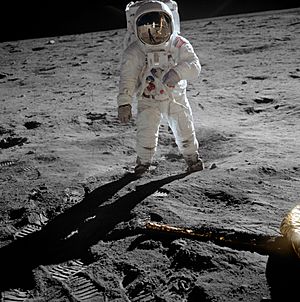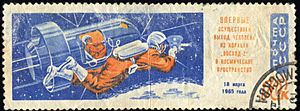Extravehicular activity facts for kids

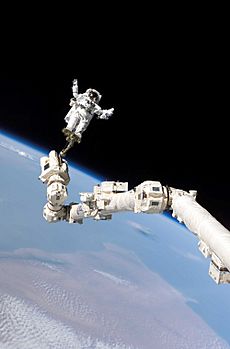
An Extravehicular Activity (often called EVA or a spacewalk) is when an astronaut leaves their spacecraft to work in outer space. Because there's no air in space, astronauts must wear a special space suit to stay safe and breathe.
EVAs include spacewalks done while orbiting Earth, and also "moonwalks" when astronauts explored the Moon's surface. Sometimes, an astronaut might just stand up through an open hatch without fully leaving the spacecraft; this is called a stand-up EVA (SEVA). Many countries and space agencies have done EVAs, including Russia, the United States, Canada, the European Space Agency, and China.
The first person to ever do a spacewalk was Alexei Leonov from the Soviet Union on March 18, 1965. He spent about 12 minutes outside his Voskhod 2 spacecraft. Later, on July 20, 1969, Neil Armstrong became the first person to walk on the Moon during the Apollo 11 mission. His moonwalk lasted over 2 and a half hours.
In 1984, Svetlana Savitskaya became the first woman to perform a spacewalk. She worked outside the Salyut 7 space station for over 3 and a half hours. Astronauts have also used EVAs to fix spacecraft, like when American astronauts repaired Skylab, the first U.S. space station, in 1973.
Spacewalks can be either 'tethered' or 'untethered'. In a tethered spacewalk, the astronaut is connected to the spacecraft by a strong cable. This cable can provide oxygen and power, and it keeps the astronaut from floating away. Untethered spacewalks are rare. They were only done a few times in 1984 using a special jetpack called the Manned Maneuvering Unit (MMU).
Contents
History of Spacewalks
The idea of "extravehicular activity" (EVA) came about in the early 1960s during the Apollo program. This program aimed to land humans on the Moon, and astronauts would need to leave their spacecraft to collect samples and set up science experiments.
To prepare for this, the Gemini program was created. It focused on teaching astronauts how to work outside a spacecraft orbiting Earth. The Soviet Union was also trying to be first in space. They quickly changed their single-pilot Vostok capsule into a two or three-person craft called Voskhod to compete with Gemini and Apollo.
Because of how their spacecraft were built, the American and Soviet space programs had different ways of defining when a spacewalk started. For the Soviets, an EVA began when the outer door of the airlock opened and the cosmonaut was in the vacuum of space. For Americans, it started when the astronaut's head was outside the spacecraft. The U.S. has since changed its definition.
The First Spacewalk
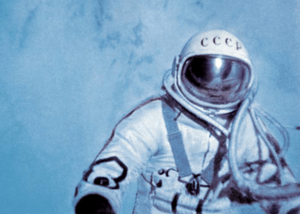
The very first spacewalk happened on March 18, 1965. Soviet cosmonaut Alexei Leonov spent 12 minutes and 9 seconds outside the Voskhod 2 spacecraft. He wore a white backpack that held enough oxygen for him to breathe. Leonov was connected to the spacecraft by a 15.35 m (50.4 ft) tether. He said it was easy to move, but his space suit actually puffed up a lot in the vacuum of space. This made it so stiff that he couldn't even press the button on his camera.
Getting back into the spacecraft was even harder. Leonov had to squeeze into an inflatable airlock that was only 1.2 m (3 ft 11 in) wide. His suit was so stiff that he got stuck sideways. He had to lower the pressure in his suit to get back inside, which was risky. This added another 12 minutes to his time in space, and he became very hot from the effort. The Soviets didn't try another spacewalk for almost four years. They also kept the difficulties Leonov faced a secret until after the Cold War.
Project Gemini Spacewalks
The first American spacewalk was on June 3, 1965, by Ed White during the Gemini IV mission. He was outside for 21 minutes. White was also connected to his spacecraft by a 25-foot (7.6 m) umbilical cable, which gave him oxygen and allowed him to talk to Earth. He was the first to use a special hand-held device to move around in space, which worked well but only had enough fuel for 20 seconds. White found his tether helpful for staying close to the spacecraft, but it was hard to use for moving around.
Later Gemini missions also included spacewalks. Astronauts like Eugene Cernan, Michael Collins, and Richard Gordon tried to work outside, but they often got tired and overheated quickly.
On November 13, 1966, Edwin "Buzz" Aldrin became the first astronaut to successfully work in space for a long time without getting too tired. This happened during Gemini XII, the last Gemini mission. Aldrin spent 2 hours and 6 minutes outside the spacecraft. He also did two "stand-up" EVAs, where he stood in the open hatch for over 3 hours. Aldrin was interested in scuba diving, which led to the idea of training astronauts underwater to practice spacewalks. This "underwater EVA training" is still used today to help astronauts learn how to move efficiently in weightlessness.
Moonwalks: Apollo Missions
American astronauts Neil Armstrong and Buzz Aldrin made history on July 21, 1969, when they performed the first EVA on the Moon's surface. This happened after their Apollo 11 Lunar Module landed. For this "moonwalk," they used special backpacks that provided all their life support. This first moonwalk lasted 2 hours and 36 minutes.
In total, astronauts performed 15 moonwalks across six Apollo missions. Famous astronauts who walked on the Moon include Charles "Pete" Conrad, Alan Bean, Alan Shepard, Edgar Mitchell, David Scott, James Irwin, John Young, Charles Duke, Eugene Cernan, and Harrison "Jack" Schmitt. Eugene Cernan was the last Apollo astronaut to leave the Moon's surface.
Some Apollo astronauts also did spacewalks on their way back to Earth from the Moon. For example, Apollo 15 astronaut Al Worden went outside his spacecraft in 1971 to get film and data from the service module.
Spacewalks After Apollo
The first time astronauts repaired a spacecraft during an EVA was in 1973. Charles "Pete" Conrad, Joseph Kerwin, and Paul J. Weitz fixed the Skylab space station after it was damaged during launch. They freed a stuck solar panel, put up a sun shield, and fixed a circuit breaker. The three Skylab crews performed a total of ten EVAs. They found that working in weightlessness took about 2.5 times longer than on Earth, partly because many astronauts felt sick early in their flights.
After Skylab, the United States didn't do any more EVAs until the Space Shuttle program began in the early 1980s. During this time, the Soviets continued their spacewalks from the Salyut 6 and Salyut 7 space stations.
When the U.S. started EVAs again in 1983, astronauts began using a self-contained suit called the Extravehicular Mobility Unit (EMU). This suit provided all the life support. For the first time, American astronauts used an airlock to enter and exit the spacecraft, just like the Soviets. So, the American definition of an EVA changed to when the astronaut switched their EMU to battery power.
Many spacewalks have been done to build the ISS. Astronauts often use the Quest Joint Airlock, which can support both U.S. EMUs and Russian Orlan space suits.
Chinese Spacewalks

China became the third country to perform its own EVA on September 27, 2008, during the Shenzhou 7 mission. Chinese taikonaut Zhai Zhigang completed a 22-minute spacewalk wearing a Chinese-made Feitian space suit. Another taikonaut, Liu Boming, helped him while wearing a Russian-made Orlan space suit and standing at the airlock. Zhai fully left the craft, while Liu stayed at the opening.
Since 2021, China has done several more spacewalks, lasting many hours, to build their Tiangong space station.
SpaceX Spacewalks
The American company SpaceX performed the first privately funded EVA on September 12, 2024. Entrepreneur Jared Isaacman and SpaceX engineer Sarah Gillis briefly went outside a Dragon capsule. This was a stand-up EVA (SEVA) during the Polaris Dawn mission, used to test how well the new spacesuits moved. The other two crew members were also exposed to space vacuum inside the capsule but did not leave it. SpaceX plans more missions with EVAs, including one using their new Starship vehicle.
Spacewalk Milestones
Key Achievements in Spacewalks
- The first untethered spacewalk was done by American Bruce McCandless II on February 7, 1984, during the Space Shuttle Challenger mission STS-41-B. He used the Manned Maneuvering Unit (MMU), a jetpack that allowed him to fly freely in space.
- The first time metalwork was done in open space happened on July 25, 1984. Soviet cosmonauts Svetlana Savitskaya and Vladimir Dzhanibekov performed welding, brazing, and metal spraying outside the Salyut 7 space station.
- The only three-person EVA ever happened on May 13, 1992, during STS-49, the first flight of the Space Shuttle Endeavour. Pierre Thuot, Richard Hieb, and Thomas Akers worked together to catch and repair a broken satellite.
- The first spacewalk to repair the Space Shuttle in space was by American Steve Robinson on August 3, 2005, during mission STS-114. Robinson removed two pieces of material from Discovery's heat shield while it was docked to the International Space Station.
- The longest EVA ever recorded, as of January 2022, lasted 8 hours and 56 minutes. It was performed by Susan Helms and James S. Voss on March 11, 2001.
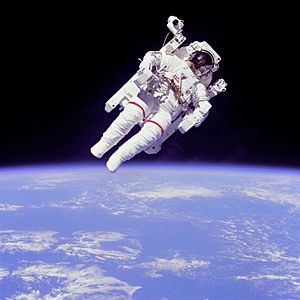
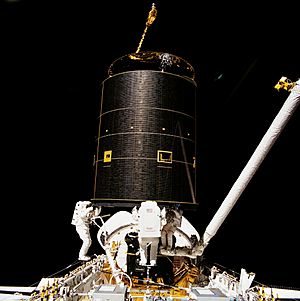
Records for Time Spent Spacewalking
- Russian cosmonaut Anatoly Solovyev holds the record for the most spacewalks (16 EVAs) and the most total time spent spacewalking (82 hours and 22 minutes). He achieved this over four missions to the Mir space station between 1990 and 1998.
- Michael Lopez-Alegria holds the American record, with 10 EVAs totaling 67 hours and 40 minutes.
- Thomas Pesquet holds the European record, with 6 EVAs totaling 39 hours and 54 minutes.
- Peggy Whitson holds the record for women, with 10 EVAs totaling 60 hours and 21 minutes.
Firsts by Nationality, Ethnicity, and Gender
- The first woman to perform an EVA was Soviet Svetlana Savitskaya on July 25, 1984. Her spacewalk lasted 3 hours and 35 minutes.
- The first American woman to perform an EVA was Kathryn D. Sullivan on October 11, 1984.
- The first time two women performed an EVA together was on October 18, 2019, by Christina Koch and Jessica Meir on the International Space Station.
- The first female Asian and Chinese woman to perform an EVA was Wang Yaping on November 8, 2021, outside the Chinese Tiangong space station.
- The first Native American woman to perform a spacewalk was Nicole Aunapu Mann on January 20, 2023.
- The first EVA by a non-Soviet, non-American astronaut was on December 9, 1988, by Jean-Loup Chrétien from France.
- The first EVA by a Black African-American astronaut was on February 9, 1995, by Bernard A. Harris Jr..
- The first EVA by a Japanese astronaut was on November 25, 1997, by Takao Doi.
- The first EVA by a Canadian astronaut was on April 22, 2001, by Chris Hadfield. He helped install the Canadarm2 on the International Space Station.
- The first EVA by a Chinese astronaut was on September 27, 2008, by Zhai Zhigang. This made China the third country to perform its own EVA.
- The first EVA by an Arab astronaut was on April 28, 2023, by Emirati astronaut Sultan Al Neyadi.
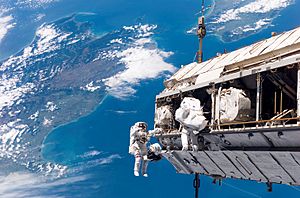
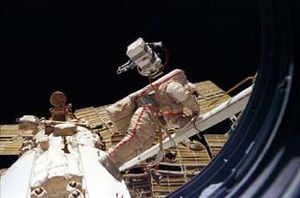
Commemorating Spacewalks
The first spacewalk by Soviet cosmonaut Alexei Leonov was celebrated in 1965 with several stamps from Eastern European countries. Since the Soviet Union kept details of the Voskhod spacecraft secret, the pictures of the spaceship on these stamps were made up.
The U.S. Post Office also issued a stamp in 1967 to remember Ed White's first American spacewalk. This stamp shows an accurate picture of the Gemini IV spacecraft and White's space suit.
Preparing for a Spacewalk
For spacewalks from the International Space Station, NASA used a special "camp-out" procedure to reduce the risk of decompression sickness (also known as "the bends"). This was first tested by the Expedition 12 crew. During a camp-out, astronauts would sleep overnight in the airlock. The air pressure in the airlock was lowered to 10.2 psi (70 kPa), which is less than the normal station pressure of 14.7 psi (101 kPa). Spending a night at lower pressure helps remove nitrogen from the body, which prevents "the bends." More recently, astronauts have used a different method called the "In-Suit Light Exercise protocol" to prevent decompression sickness.
See also
 In Spanish: Actividad extravehicular para niños
In Spanish: Actividad extravehicular para niños
- List of cumulative spacewalk records
- List of International Space Station spacewalks
- List of Mir spacewalks
- List of spacewalkers
- Omega Speedmaster
- Suitport
- The Age of Pioneers, a 2017 film about the first spacewalk


